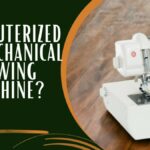Hey there! You might have heard through the grapevine about the power of nylon thread, often hailed as the go-to for any heavy-duty stitching. But the burning question is, can you actually whip it out and use it on your sewing machine without any issues, or is it just an urban myth?
Let’s dive into the world of nylon thread and separate the facts from the fiction.
We’ll take a look at how it jives with various sewing machines, check out the good, the bad, and the ugly, and we’ll also share some neat tricks for sewing with it.
And if nylon doesn’t float your boat, no sweat! We’ve got some other options lined up for you.
So strap in, it’s time to thread the needle and get started!
Can Nylon Thread be Used on a Sewing Machine?
Yes, nylon thread can be used on a sewing machine, particularly for projects that require durability, like outdoor gear. But keep in mind that tension adjustments might be necessary, and not all machines can handle nylon thread effectively.
So, you’re curious about the ins and outs of nylon thread, huh? Let’s start from the top. The creation of nylon thread kicks off with a fascinating chemical reaction, forming these incredibly long polymer chains which give us a super strong, yet flexible material. Picture it – this material is then stretched and pulled into thin strands.
Now, let’s chat about the different breeds of nylon thread out there. Basically, we’ve got two main players in the game, monofilament and multifilament.
Monofilament, for starters, is like the lone wolf of the thread world – a single, continuous filament that’s transparent and packs a serious punch in terms of tensile strength. It’s the go-to choice for things like quilting or beading.
On the flip side, multifilament is like a bundle of joy. It’s made up of a bunch of filaments, all twisted together to offer a softer, more flexible thread. It’s the perfect pick for sewing clothes.
The Compatibility of Nylon Thread With Sewing Machines
So, let’s talk about nylon thread and sewing machines. Guess what? They’re pretty much besties! You can totally use nylon thread with most sewing machines as long as you’re clued in on a few key details.
First off, nylon thread ain’t no pushover. It’s a tough cookie! Unlike cotton thread, nylon is way stronger and can totally stay the course, especially when it comes to those hardcore sewing projects.
So, if you’re going to jump on the nylon thread bandwagon, here are a few pro tips to keep in mind:
- Tough As Nails: Nylon thread is super durable. It’s more than capable of keeping up with your sewing machine, even when you’re going pedal to the metal.
- Tweaking the Machine: You might need to play around with the thread tension. Nylon thread’s got a different vibe and strength than cotton, so you might need to tweak a few things.
- Size Matters: Pick the right size nylon thread. You’ve got options, buddy! There are different thicknesses to choose from, each best suited for different types of fabric.
- Needle Know-How: You gotta use the right needle. If you’re using nylon thread, you might need a bigger needle to handle its toughness and thickness.
Advantages and Disadvantages of Using Nylon Thread
When it comes to sewing, nylon thread has quite a few things going for it, but it’s not all sunshine and rainbows. First off, the stuff is super tough – we’re talking really strong and hardwearing. It’s got the edge in the ‘nylon versus everything else’ debate because of its ability to take on those hardcore sewing projects like a champ. Plus, it laughs in the face of heat, mold, mildew, and even chemicals.
However, don’t think it’s all smooth sailing. Nylon thread can be a bit of a slippery customer, making it a tad tricky to handle at times. And then there’s the big elephant in the room – its impact on the environment. Nylon is a synthetic material and doesn’t break down naturally over time, making it a bit of a nightmare for our planet. Its production and disposal process aren’t exactly a walk in the park for the environment either.
Tips for Sewing With Nylon Thread Successfully
So, you’ve weighed up the good and the bad of sewing with nylon thread, right? Okay, let’s get down to the nitty-gritty and go over some hacks that’ll set you up for a win when you’re working with this stuff.
- Messing with the Tension: Nylon thread’s got a slick vibe going on, way more than your regular cotton. So, you gotta play around with the tension on your sewing machine to steer clear of those annoying puckers or missed stitches. Kick things off with a chill setting, then slowly crank it up until your stitches are looking on point.
- Taking Care of Your Nylon Thread: This one’s crucial. Keep your nylon thread out of the sun and away from heat. You don’t want it getting all brittle on you.
- Picking the Right Needle: Not all needles are created equal, my friend. For nylon thread, a size 90/14 needle is your golden ticket.
- Take It Easy with the Stitches: Sure, nylon thread is tough as nails, but push it too hard, too fast and it could melt or snap on you. Keep things slow and steady for those smooth, even stitches.
Don’t forget, it’s all about that practice. Keep at it until you nail it. Happy stitching!
Conclusion: Making the Most Out of Your Textile Adventure
Whoa, are we still talking about nylon threads and sewing machines? Yeah, we are. We’ve covered a crazy amount of material, but the journey’s only beginning. When it comes to the craft, there’s so much more to uncover, and every sewing technique you learn is another feather in your cap.
But wait! Before we finish up, there are few mind-bending aspects of sewing you might not have thought of. Ever pondered if the sewing machine could affect pregnancy? Sounds pretty wild, right? The increasing concern for indoor pollutants and the effect they can have on pregnancy might give you a pause. Well, fret not! Dive into our link for some peace of mind.
And oh, how about that tricky Velcro situation? You might wanna check out how you can sew velcro on with a sewing machine. Trust me, this simple tweak could make your sewing life so much easier.
Now, for the love of invisible threads. If you’re in that camp which loves the invisible look, do you know if you can you use invisible thread in a sewing machine? We’ve got that covered too. Go check it out to up your game.
So much to learn, so much to apply. Having a sewing machine isn’t just about threading the needle, it’s about understanding how every action can affect your whole experience.
Remember, practice makes perfect. So, keep stitching your story, one thread at a time.
I am a proud mother of two amazing daughters, and i run our sewing & embroidery business full time. I am also a part-time writer for this blog, because i love sharing my findings and experiences!






